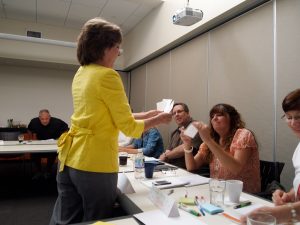How to Design Professional Development that Turns Your Users Into Repeat Customers
Ed-tech entrepreneurs need to realize that selling a product to a school is only the very first part of a relationship.
Getting a foot in the door is commendable because quite often it’s really hard work. Yet the real sale happens when teachers actually use (and love) your product. Most teachers aren’t interested in using a new product until they understand it and trust it completely, which is usually accomplished through professional development.
Thinking about the following questions when you design your PD will help ensure that teachers feel confident and are excited about using your product in their classrooms.
1. How much time do my customers usually have available to commit to PD? How much PD is needed to really understand how to use my product?
PD can range from five days of in-person workshops to one or two hours of self-paced online learning, so develop the version that matches up best with your product and the needs of your customers. Statistically, teachers say that longer-term PD serves them better in their teaching practice (Gates Foundation, 2014), so consider options that let teachers pace themselves over time. For example, PD with an online component gives teachers the ability to continue returning to the course over the span of a semester or year. They will be less worried about running out of time, which means they will be able to tinker, play, and discover throughout your their PD experience.
2. What is the end goal for our PD offering?
For instance, is a given PD option preparing teachers to teach a specific course in the short-term, or helping them build an adaptive set of skills? Teachers who are looking for more than just a short-term, “How do I use this tool” will be looking for a different experience than those who want to know the “why” behind the “how.” To develop themselves as a professional in the long-run, most teachers will prefer an interactive project-based learning experience. The general consensus among teachers is the best PD programs “…involve hands-on strategies for the teacher to actually participate in” (Gates Foundation, 2014).
3. Which do teachers prefer: an independent PD experience or mentorship-based learning experience?
An online PD experience inevitably means more independence. This leads to perks including more flexibility and the ability for educators to work at their own pace. In-person PD, on the other hand, allows for face-to-face connections, leading to a more disciplined use of time. We often recommend combining online and in-person PD experiences as we find that the two together lead to the deepest learning.
4. Do teachers want to learn from fellow educators?
Teachers often prefer to learn from educators who are actually using your product rather than a representative from your company. Most teachers have had the best PD experiences when they know that the creators of the program have been in their shoes.
5. How much money is available for PD?
As you talk to more educators and get a sense for the level of PD your product requires (and teachers want), you will want to match your price appropriately. Pricing a one-hour, online, self-directed PD experience at $1,000 is most likely out of line. For help with pricing, you can conduct internet research on products similar to yours, or ask your current customers!
Constructing your PD similar to other experiences that teachers and schools know and are familiar with may seem boring. But there are ways to differentiate your PD within the experience rather than creating a format or pricing structure that is foreign or uncomfortable. Please share your successful PD models and ideas in the comments below, thanks!
Follow EdWeek Market Brief on Twitter @EdMarketBrief or connect with us on LinkedIn.
Images courtesy of Nikki Navta.
See also:

